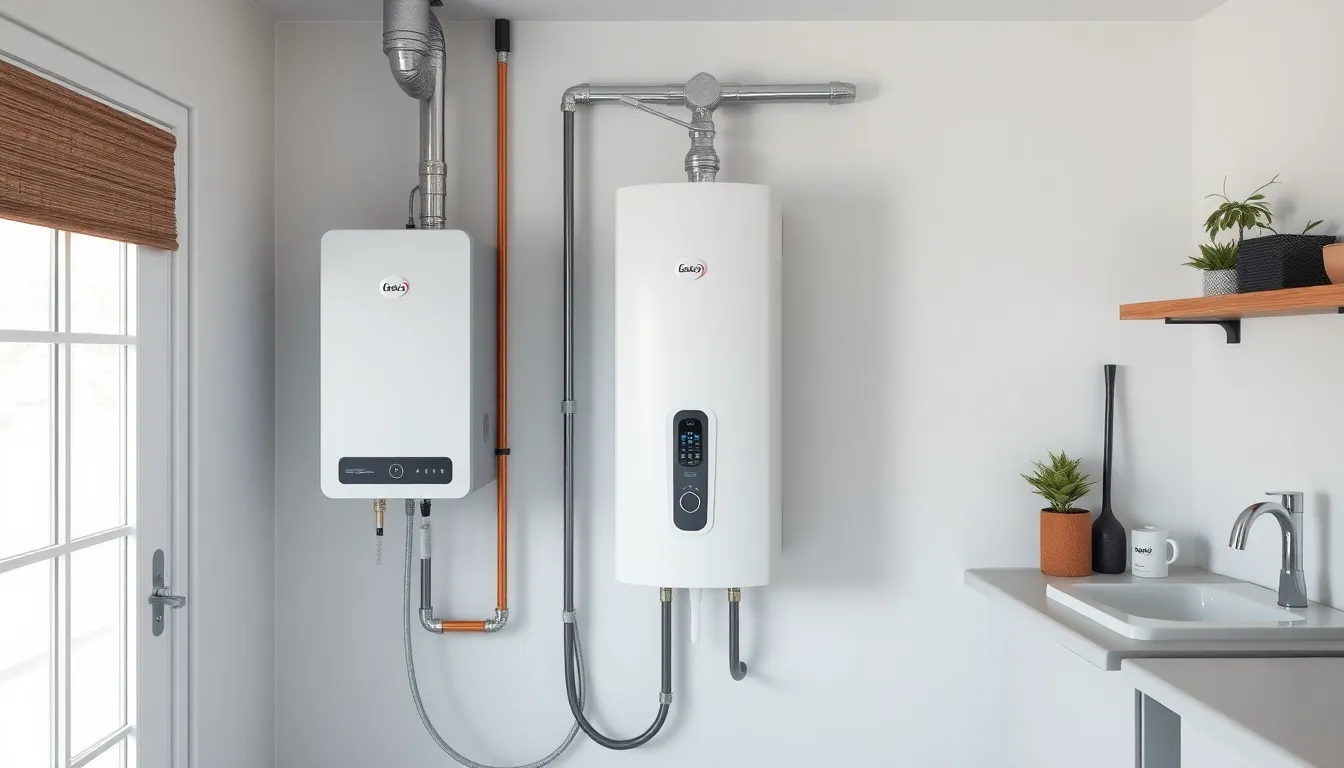Table of Contents
ToggleImagine never running out of hot water again—sounds like a dream, right? Enter the tankless water heater, the superhero of home appliances. These nifty devices heat water on demand, so you can enjoy that long shower without worrying about the cold water surprise halfway through. Who needs a bulky tank hogging space when you can have endless hot water at your fingertips?
Not only do tankless water heaters save space, but they also save energy—and who doesn’t love a lower utility bill? With their sleek design and efficiency, they’re like the minimalist’s dream come true. So, if you’re tired of the hot water race in your household, it might be time to consider making the switch. Let’s dive into the world of tankless water heaters and discover why they’re the future of home comfort.
Overview Of Tankless Water Heaters
Tankless water heaters offer immediate hot water without relying on large storage tanks. These devices enhance home efficiency while conserving energy.
What Are Tankless Water Heaters?
Tankless water heaters, commonly known as on-demand water heaters, heat water directly as needed. Unlike traditional models, they don’t store heated water, allowing for continuous access. They come in both gas and electric variants, providing flexibility in options. These units are compact, making them suitable for various home sizes, including smaller apartments and new constructions. Many homeowners appreciate their lower energy costs, which result from reduced standby heat loss.
How Do They Work?
Tankless water heaters operate through a simple process. When a hot water tap opens, cold water travels through a pipe into the unit. A powerful heating element activates, quickly warming the water. This means users receive a constant supply of hot water instead of waiting for a tank to refill. The efficiency of these systems depends on factors such as flow rate and the heater’s power. With smaller units designed for single applications and larger ones capable of serving multiple outlets, there’s an option for every household need.
Advantages Of Tankless Water Heaters
Tankless water heaters offer several compelling benefits, enhancing home comfort while promoting energy savings. Homeowners appreciate these advantages, boosting interest in on-demand water heating systems.
Energy Efficiency
Energy efficiency ranks among the top advantages of tankless water heaters. Unlike traditional systems, these units heat water solely when needed, reducing energy waste significantly. According to the U.S. Department of Energy, homes can save up to 30% on water heating costs by switching to tankless systems. Energy usage lowers due to the absence of standby heat loss, which occurs in conventional water heaters. Moreover, many models feature energy-saving modes, further optimizing performance. Therefore, opting for a tankless water heater often results in more efficient energy consumption and reduced utility bills.
Space-Saving Design
Space-saving design serves as another standout advantage of tankless water heaters. Unlike bulky storage tanks that require dedicated spaces, these units are compact and can be installed in smaller areas, such as closets or utility rooms. Available in both wall-mounted and standalone designs, homeowners maximize space opportunities in their homes. Tankless water heaters can meet household demands without occupying significant floor space. This flexibility aligns especially well with smaller homes or apartments. Reduced space requirements enhance functionality and improve overall home aesthetics.
Disadvantages Of Tankless Water Heaters
Tankless water heaters offer numerous benefits, but they’re not without drawbacks. Consider the following disadvantages before making a decision.
Initial Costs
High initial costs represent a significant barrier for many homeowners. Purchasing a tankless water heater typically requires a larger upfront investment compared to traditional tank models, with estimates ranging from $1,000 to $3,000. Installation expenses further increase this figure, especially if gas lines or electrical wiring require upgrades. For budget-conscious consumers, navigating these costs poses a challenge.
Flow Rate Limitations
Flow rate limitations often lead to dissatisfaction in larger households. Tankless systems can struggle to meet hot water demands when multiple outlets operate simultaneously. For instance, running a shower and dishwasher at the same time may result in insufficient hot water. Homeowners may need to purchase larger units or additional systems to mitigate these issues, adding to the overall expense and complexity.
Popular Brands And Models
Numerous brands and models dominate the tankless water heater market, each offering specific features and benefits. Many homeowners seek trusted names to ensure reliability and efficiency.
Brand Comparisons
Rinnai stands out for its continuous flow technology, providing consistent hot water even during peak usage times. EcoSmart offers energy-efficient electric models, appealing to environmentally-conscious consumers. Navien excels in combining advanced technology with user-friendly controls, making installations seamless. Bosch’s compact design suits smaller spaces, while maintaining high performance levels. Rheem features a variety of models for different household sizes, ensuring there’s a suitable option for nearly everyone.
Model Features
Rinnai’s RUC98i model boasts up to 9.8 GPM flow rate, making it ideal for larger families. EcoSmart’s ECO 27 offers a 27 kW heating element, providing ample hot water while optimizing energy consumption. Navien’s NPE-240A includes an innovative condensing design, increasing efficiency by recycling heat. Bosch’s Greentherm exceeds industry energy standards, further reducing monthly bills. Rheem’s Performance Model incorporates Wi-Fi capability for remote monitoring and control, enhancing user experience and convenience.
Installation And Maintenance
Proper installation and regular maintenance are crucial for the optimal performance of tankless water heaters. Understanding these aspects ensures longevity and efficiency.
Installation Considerations
Choose the right location for the unit, ideally near the most-used hot water outlets. Ventilation matters; gas models require proper exhaust systems to prevent carbon monoxide buildup. Sizing the unit based on household needs is essential; evaluate the number of faucets and appliances that use hot water simultaneously. Electrical requirements must be checked for electric models, ensuring the home’s wiring can handle the load. If applicable, consider upgrading gas lines as this can affect performance. Professional installation is often recommended to address safety and compliance with local building codes.
Maintenance Tips
Routine maintenance enhances the lifespan of tankless water heaters. Flush the unit annually to remove mineral buildup, which can hinder performance. Inspect the filters and clean them regularly to ensure optimal water flow. Check for leaks around the unit periodically; any signs of water should be addressed immediately. Adjust the thermostat settings according to seasonal needs to boost efficiency. Consider professional maintenance every few years for a comprehensive checkup, ensuring all components function correctly and safely.
Conclusion
Tankless water heaters offer a modern solution for homeowners seeking efficiency and convenience. With their compact design and ability to provide endless hot water on demand, they stand out as a practical choice for various living spaces. While the initial investment can be significant, the long-term savings on energy bills and the benefits of reduced standby heat loss make them an attractive option.
As technology continues to advance, these systems are becoming more reliable and user-friendly. Proper installation and maintenance are crucial for maximizing their performance. For those ready to enhance their home’s comfort and efficiency, exploring tankless water heaters could be a smart move.





